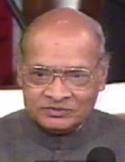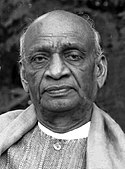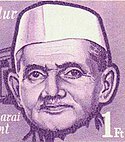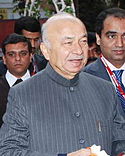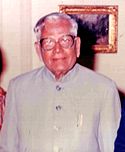Ministerstwo Spraw Wewnętrznych Indii
| IndieTen artykuł jest częścią serii: Ustrój i polityka Indii Ustrój polityczny Konstytucja Władza ustawodawcza Władza wykonawcza Władza sądownicza Kontrola państwowa Finanse Samorząd terytorialny Partie polityczne Wybory Polityka zagraniczna Wikiprojekt Polityka |
Ministerstwo Spraw Wewnętrznych Indii − ministerstwo odpowiadające za prowadzenie polityki wewnętrznej Indii.
Mieści się w kompleksie rządowym w Raisina Hill w Nowym Delhi.
Obecnym ministrem spraw zagranicznych jest Rajnath Singh.
Lista ministrów spraw wewnętrznych Indii
Poniższa tabela zawiera listę wszystkich ministrów spraw wewnętrznych Indii, od uzyskania przez ten kraj niepodległości w 1947[1].
| Imię i nazwisko | Zdjęcie | Od | Do | Partia | Uwagi |
|---|---|---|---|---|---|
| Vallabhbhai Patel |  | 15 sierpnia 1947 | 15 grudnia 1950 | INC | |
| Chakravarthi Rajagopalachari |  | 26 grudnia 1950 | 25 października 1951 | INC | |
| Kailash Nath Katju | 25 października 1951 | 10 stycznia 1955 | INC | ||
| Govind Ballabh Pant |  | 10 stycznia 1955 | 7 marca 1961 | INC | |
| Lal Bahadur Shastri |  | 4 kwietnia 1961 | 29 sierpnia 1963 | INC | |
| Gulzarilal Nanda | 29 sierpnia 1963 | 14 listopada 1966 | INC | ||
| Yashwantrao Chavan[2] | 14 listopada 1966 | 27 czerwca 1970 | INC | pierwszy raz | |
| Indira Gandhi[3] |  | 27 czerwca 1970 | 4 lutego 1973 | INC | równocześnie premier |
| Uma Shankar Dikshit | 4 lutego 1973 | 10 października 1974 | INC | ||
| Kasu Brahmananda Reddy | 10 października 1974 | 27 marca 1977 | INC | ||
| Charan Singh | 27 marca 1977 | 1 lipca 1978 | Janata | ||
| Morarji Desai[4] | 1 lipca 1978 | 30 lipca 1979 | Janata | ||
| Yashwantrao Chavan | 30 lipca 1979 | 14 stycznia 1980 | Janata Party (Secular) | drugi raz | |
| Giani Zail Singh | 14 stycznia 1980 | 22 czerwca 1982 | INC | ||
| Ramaswamy Venkataraman |  | 22 czerwca 1982 | 2 września 1982 | INC | |
| Prakash Chandra Sethi | 2 września 1982 | 19 lipca 1984 | INC | ||
| P.V. Narasimha Rao |  | 19 lipca 1984 | 31 grudnia 1984 | INC | pierwszy raz |
| Shankarrao Chavan[5] | 31 grudnia 1984 | 12 marca 1986 | INC | pierwszy raz | |
| P.V. Narasimha Rao |  | 12 marca 1986 | 12 maja 1986 | INC | drugi raz |
| Buta Singh |  | 12 maja 1986 | 5 grudnia 1989 | INC | |
| Mufti Mohammad Sayeed | 5 grudnia 1989 | 21 listopada 1990 | Janata Dal (1988–1999) | ||
| Chandra Shekhar | 21 listopada 1990 | 21 czerwca 1991 | Samajwadi Janata Party | ||
| Shankarrao Chavan | 21 czerwca 1991 | 16 maja 1996 | INC | drugi raz | |
| Murli Manohar Joshi | 16 maja 1996 | 1 czerwca 1996 | Indyjska Partia Ludowa | ||
| H.D. Deve Gowda[6] |  | 1 czerwca 1996 | 29 czerwca 1996 | Janata Dal (Secular) | |
| Indrajit Gupta | 29 czerwca 1996 | 19 marca 1998 | Komunistyczna Partia Indii | ||
| Lal Krishna Advani |  | 19 marca 1998 | 23 maja 2004 | Indyjska Partia Ludowa | |
| Shivraj Patil |  | 23 maja 2004 | 30 listopada 2008 | INC | |
| Palaniappan Chidambaram[7] |  | 30 listopada 2008 | 31 lipca 2012 | INC | |
| Sushil Kumar Shinde |  | 31 lipca 2012 | 26 maja 2014 | INC | |
| Rajnath Singh | 27 maja 2014 | Indyjska Partia Ludowa |
Przypisy
- ↑ rulers.org: India. Ministries, etc.
- ↑ Yashwantrao Balwantrao Chavan w rulers.org
- ↑ Indira Gandhi w rulers.org
- ↑ Morarji Desai w rulers.org
- ↑ Shankarrao Chavan w rulers.org
- ↑ H.D. Deve Gowda w rulers.org
- ↑ Palaniappan Chidambaram w rulers.org
Bibliografia
Linki zewnętrzne
Media użyte na tej stronie
Prime Minister Narasimha Rao addressing a joint session of US congress
A portrait of Sardar Patel on his 74th birthday, 1949.
(c) Bollywood Hungama, CC BY 3.0
Buta Singh & Shakeel Saifi snapped at DJ Sheizwoods house
The National Emblem of India is derived from the time of the Emperor Ashoka. The emblem is a replica of the Lion of Sarnath, near Varanasi in Uttar Pradesh. The Lion Capital was erected in the third century BC by Emperor Ashoka to mark the spot where Buddha first proclaimed his gospel of peace and emancipation to the four quarters of the universe. The national emblem is thus symbolic of contemporary India’s reaffirmation of its ancient commitment to world peace and goodwill. The four lions(one hidden from view ) – symbolising power, courage and confidence- rest on a circular abacus. The abacus is girded by four smaller animals—Guardians of the four directions: The Lion of the North, The Horse of the West, The Bull of the South and The Elephant of the East. The abacus rests on a lotus in full bloom, exemplifying the fountainhead of life and creative inspiration. The motto 'Satyameva Jayate' inscribed below the emblem in Devanagari script means 'truth alone triumphs'.
Autor: photobyarvind, Licencja: CC BY-SA 2.0
Shivraj Patil, current Minister for Home Affairs of en:India
Lal Bahadur Shastri, the 2nd Prime minister of India.
Image cropped from the original using GIMP 2.6.10.
Autor: Copyright World Economic Forum (www.weforum.org)/Photo by Norbert Schiller, Licencja: CC BY-SA 2.0
India's Minister of Finance Palaniappan Chidambaram is the special guest at a plenary session titled Risks to India's Economy in a Post-Crisis World held at the World Economic Forum's India Economic Summit 2008 in New Delhi, 16-18 November 2008.
Cropped photograph of L K Advani with Hillary Clinton outside his residence.
Elecrama 2010 - Inaguration by Mr. Sushil Kumar Shinde, Honorable Union Minister for Power, Government of India (Jan 2010)
C. Rajagopalachari during the Gandhi-Jinnah talks at Birla House, Mumbai, September 1944.
A portrait of Govind Ballabh Pant taken in May 1952

